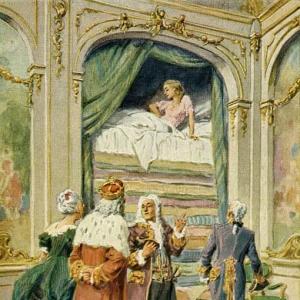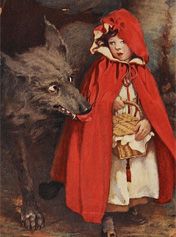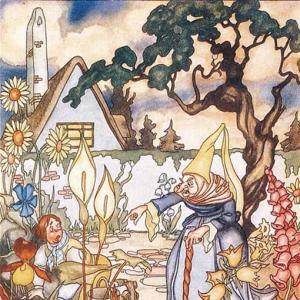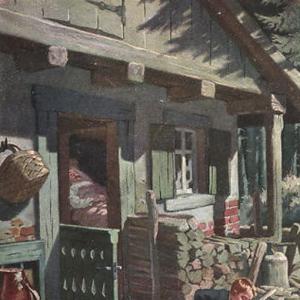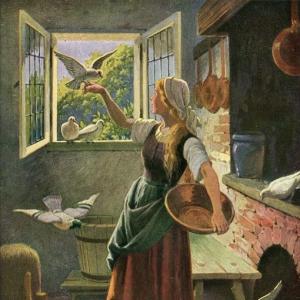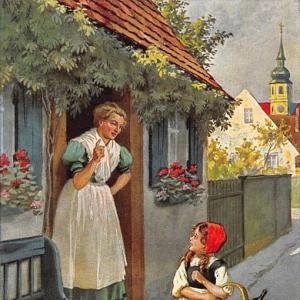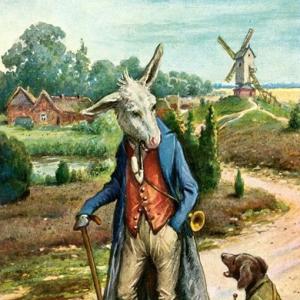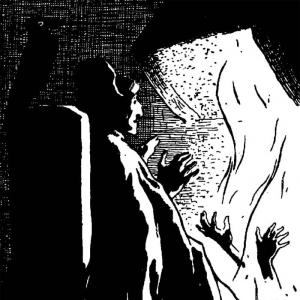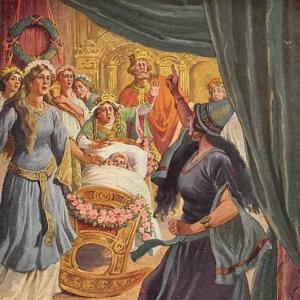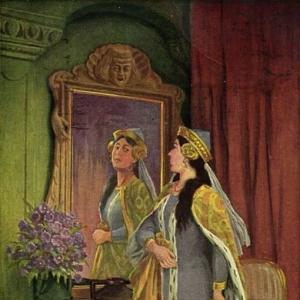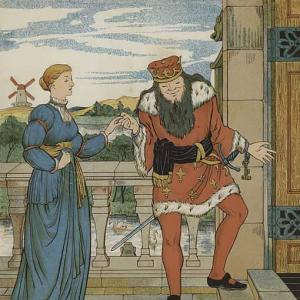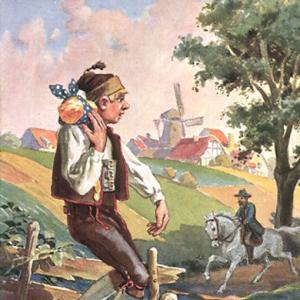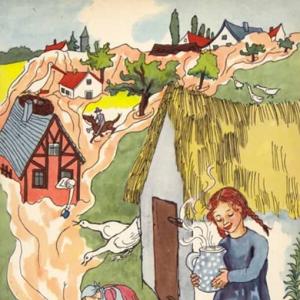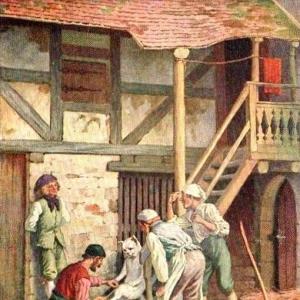Reading time for children: 11 min
There was once a poor peasant who had no land, but only a small house, and one daughter. Then said the daughter, „We ought to ask our lord the King for a bit of newly-cleared land.“ When the King heard of their poverty, he presented them with a piece of land, which she and her father dug up, and intended to sow with a little corn and grain of that kind. When they had dug nearly the whole of the field, they found in the earth a mortar made of pure gold. „Listen,“ said the father to the girl, „as our lord the King has been so gracious and presented us with the field, we ought to give him this mortar in return for it.“ The daughter, however, would not consent to this, and said, „Father, if we have the mortar without having the pestle as well, we shall have to get the pestle, so you had much better say nothing about it.“ He would, however, not obey her, but took the mortar and carried it to the King, said that he had found it in the cleared land, and asked if he would accept it as a present. The King took the mortar, and asked if he had found nothing besides that? „No,“ answered the countryman. Then the King said that he must now bring him the pestle. The peasant said they had not found that, but he might just as well have spoken to the wind. He was put in prison, and was to stay there until he produced the pestle. The servants had daily to carry him bread and water, which is what people get in prison, and they heard how the man cried out continually, „Ah! if I had but listened to my daughter! Alas, alas, if I had but listened to my daughter!“ and would neither eat nor drink. So he commanded the servants to bring the prisoner before him, and then the King asked the peasant why he was always crying, „Ah! if I had but listened to my daughter!“ and what it was that his daughter had said. „She told me that I ought not to take the mortar to you, for I should have to produce the pestle as well.“ – „If you have a daughter who is as wise as that, let her come here.“ She was therefore obliged to appear before the King, who asked her if she really was so wise, and said he would set her a riddle, and if she could guess that, he would marry her. She at once said yes, she would guess it. Then said the King, „Come to me not clothed, not naked, not riding, not walking, not in the road, and not out of the road, and if thou canst do that I will marry thee.“ So she went away, put off everything she had on, and then she was not clothed, and took a great fishing net, and seated herself in it and wrapped it entirely round and round her, so that she was not naked, and she hired an ass, and tied the fisherman’s net to its tail, so that it was forced to drag her along, and that was neither riding nor walking. The ass had also to drag her in the ruts, so that she only touched the ground with her great toe, and that was neither being in the road nor out of the road. And when she arrived in that fashion, the King said she had guessed the riddle and fulfilled all the conditions. Then he ordered her father to be released from the prison, took her to wife, and gave into her care all the royal possessions. Now when some years had passed, the King was once drawing up his troops on parade, when it happened that some peasants who had been selling wood stopped with their waggons before the palace. Some of them had oxen yoked to them, and some horses. There was one peasant who had three horses, one of which was delivered of a young foal, and it ran away and lay down between two oxen which were in front of the waggon. When the peasants came together, they began to dispute, to beat each other and make a disturbance, and the peasant with the oxen wanted to keep the foal, and said one of the oxen had given birth to it, and the other said his horse had had it, and that it was his. The quarrel came before the King, and he give the verdict that the foal should stay where it had been found, and so the peasant with the oxen, to whom it did not belong, got it. Then the other went away, and wept and lamented over his foal. Now he had heard how gracious his lady the Queen was because she herself had sprung from poor peasant folks, so he went to her and begged her to see if she could not help him to get his foal back again. Said she, „Yes, I will tell you what to do, if thou wilt promise me not to betray me. Early to-morrow morning, when the King parades the guard, place thyself there in the middle of the road by which he must pass, take a great fishing-net and pretend to be fishing; go on fishing, too, and empty out the net as if thou hadst got it full“ and then she told him also what he was to say if he was questioned by the King. The next day, therefore, the peasant stood there, and fished on dry ground. When the King passed by, and saw that, he sent his messenger to ask what the stupid man was about? He answered, „I am fishing.“ The messenger asked how he could fish when there was no water there? The peasant said, „It is as easy for me to fish on dry land as it is for an ox to have a foal.“ The messenger went back and took the answer to the King, who ordered the peasant to be brought to him and told him that this was not his own idea, and he wanted to know whose it was? The peasant must confess this at once. The peasant, however, would not do so, and said always, God forbid he should! the idea was his own. They laid him, however, on a heap of straw, and beat him and tormented him so long that at last he admitted that he had got the idea from the Queen.
When the King reached home again, he said to his wife, „Why hast thou behaved so falsely to me? I will not have thee any longer for a wife; thy time is up, go back to the place from whence thou camest to thy peasant’s hut.“ One favour, however, he granted her. She might take with her the one thing that was dearest and best in her eyes; and thus was she dismissed. She said, „Yes, my dear husband, if you command this, I will do it,“ and she embraced him and kissed him, and said she would take leave of him. Then she ordered a powerful sleeping draught to be brought, to drink farewell to him. The King took a long draught, but she took only a little. He soon fell into a deep sleep, and when she perceived that, she called a servant and took a fair white linen cloth and wrapped the King in it, and the servant was forced to carry him into a carriage that stood before the door, and she drove with him to her own little house. She laid him in her own little bed, and he slept one day and one night without awakening, and when he awoke he looked round and said, „Good God! where am I?“ He called his attendants, but none of them were there. At length his wife came to his bedside and said, „My dear lord and King, you told me I might bring away with me from the palace that which was dearest and most precious in my eyes I have nothing more precious and dear than yourself, so I have brought you with me.“ Tears rose to the King’s eyes and he said, „Dear wife, thou shalt be mine and I will be thine,“ and he took her back with him to the royal palace and was married again to her, and at the present time they are very likely still living.
 Learn languages. Double-tap on a word.Learn languages in context with Childstories.org and Deepl.com.
Learn languages. Double-tap on a word.Learn languages in context with Childstories.org and Deepl.com.Backgrounds
Interpretations
Adaptions
Summary
Linguistics
„The Peasant’s Wise Daughter“ is a German fairy tale collected by the Brothers Grimm in their famous compilation, „Grimms‘ Fairy Tales“ (originally titled „Kinder- und Hausmärchen“ in German). The Brothers Grimm, Jacob (1785-1863) and Wilhelm (1786-1859), were German academics, linguists, and cultural researchers who collected and published folklore during the 19th century. Their collection of fairy tales is one of the most famous and influential works of folklore in the world.
The Brothers Grimm sought to preserve traditional stories passed down orally through generations, fearing that they would be lost as the German society became increasingly industrialized and urbanized. Their initial aim was to create a scholarly work for academic purposes, but „Grimms‘ Fairy Tales“ eventually gained popularity among the general public, both in Germany and around the world.
The tales collected by the Brothers Grimm often contain elements of magic, fantasy, and morality, reflecting the cultural values and beliefs of the time. These stories have been adapted and reinterpreted countless times through various forms of media, including literature, film, and theater.
„The Peasant’s Wise Daughter“ is one of the lesser-known tales in the Grimm collection, but it still offers valuable lessons and themes, such as the importance of wisdom, empathy, and listening to others. The story showcases a strong, intelligent female character who uses her wit and resourcefulness to overcome adversity, providing an empowering example for readers.
„The Peasant’s Wise Daughter“ can be interpreted in various ways, highlighting different themes and moral lessons:
Wisdom and Cunning: The wise daughter’s ability to think critically and creatively is central to the story. She consistently provides valuable advice and solves problems in unconventional ways, demonstrating the importance of using one’s intelligence and cunning to navigate difficult situations.
Listening to Others: Throughout the tale, the father’s failure to listen to his daughter’s advice leads to negative consequences. This theme emphasizes the importance of being open to others‘ perspectives and acknowledging that wisdom can come from unexpected sources, regardless of their social status or background.
Love and Loyalty: The strong bond between the King and his wife is another crucial theme. Their love and loyalty towards each other ultimately overcome the challenges they face. The Queen’s devotion to her husband is demonstrated when she chooses to bring him with her when banished, showing that true love is selfless and enduring.
Social Class and Compassion: The tale also highlights the importance of compassion and empathy for people of all social classes. The Queen, who comes from a humble background, understands the plight of the peasants and uses her influence to help them. This theme encourages readers to be mindful of others‘ struggles and be willing to help those in need.
Power Dynamics: The story explores the power dynamics between the King and the Queen. While the King initially wields his authority over the Queen, she ultimately uses her wisdom and love to change the power dynamic and create a more equal partnership. This theme suggests that true strength comes from wisdom, love, and understanding, rather than authority and control.
„The Peasant’s Wise Daughter“ has been adapted into various forms of media, including plays, films, and literature. Here are a few notable adaptations:
„The Wise Woman“ by George MacDonald: This is a retelling of the tale in which the youngest daughter is replaced by a wise woman who helps the king solve his riddles. This version emphasizes the power of wisdom and the importance of valuing people for their inner qualities.
„The Wise Little Girl: Tales from the Eastern Europe“ by Tololwa M. Mollel: This is a picture book adaptation of the tale that draws on Eastern European folklore. The story is set in a medieval Eastern European village, and the protagonist is a wise little girl who solves three riddles posed by the king.
„The Peasant’s Clever Daughter“ by Heather Forest: This is another picture book adaptation of the tale that features the youngest daughter as the protagonist. The story emphasizes the importance of using one’s wits to solve problems and overcome obstacles.
„The Peasant’s Wise Daughter“ (1972): This is a Soviet film adaptation of the tale directed by Arkadiy Tigay. The film follows the basic plot of the fairy tale, with the youngest daughter solving the king’s riddles and becoming his queen.
„The Wise Girl“ by Philippa Pearce: This is a retelling of the tale that emphasizes the importance of self-knowledge and self-awareness. The protagonist is a wise girl who is able to solve the king’s riddles by understanding her own strengths and weaknesses.
These adaptations demonstrate the enduring popularity and relevance of „The Peasant’s Wise Daughter“ and its themes.
„The Peasant’s Wise Daughter“ is a fairy tale by the Brothers Grimm about a poor peasant and his wise daughter. One day, they ask the King for a piece of land, which he grants. While digging the land, they find a golden mortar, which the father decides to give to the King. The daughter advises against it, fearing they will also have to provide the pestle, but her father ignores her.
As expected, the King demands the pestle and imprisons the father when he cannot produce it. In prison, the father laments not listening to his daughter, which piques the King’s curiosity. The King meets the daughter and, impressed by her wisdom, decides to marry her if she can solve a riddle. She successfully solves the riddle, and her father is released from prison.
Years later, a dispute between peasants over a foal comes to the King’s attention. The Queen, sympathetic to the situation, advises one of the peasants on how to regain his foal. However, when the King learns that the idea came from the Queen, he banishes her back to her old peasant life. She is allowed to take one thing with her, so she chooses her husband, the King.
She drugs the King, takes him to her old home, and when he awakens, he realizes how much she loves him. The King takes her back to the palace, and they live happily ever after.
„The Peasant’s Wise Daughter“ is a tale from the Brothers Grimm that offers rich material for linguistic analysis. This story exemplifies several features of traditional fairy tales, including narrative structure, language style, and thematic elements. Here, we will explore some linguistic aspects that are characteristic of such tales:
Narrative Structure: The tale follows a common fairy tale structure, with an initial situation (a peasant and his daughter living in poverty), a complication (finding the golden mortar), climax (fulfilling the King’s riddle), and resolution (the wise daughter becomes Queen and sustains her cleverness throughout the story). It adheres to the „Rule of Three“ often found in fairy tales, such as the three conditions set by the King for the riddle, which adds rhythm and expectation for the listeners or readers.
Language Style: The language is formal and archaic, reflecting the time when the Brothers Grimm collected these tales. Phrases such as „Ah! if I had but listened to my daughter!“ showcase this older style. Dialogue is direct and serves to advance the plot, highlighting the characters‘ motivations and intelligence, especially the daughter’s. Repetitive phrasing is used for emphasis and to aid memorability, e. g. , „Ah! if I had but listened to my daughter!“
Characterization: Characters often embody archetypes. Here, the peasant’s daughter is the embodiment of wisdom and cleverness, a common theme in fairy tales where simple characters outwit the powerful. Indirect characterization through actions and decisions is prevalent. The daughter’s wisdom is shown through her actions, like solving the riddle and cleverly ensuring her place as Queen.
Thematic Elements: Themes of justice and fairness are explored, such as the initial unfair imprisonment of the father and the eventual just resolution through the daughter’s wisdom. There is an exploration of the social hierarchy with the marriage between the peasant’s daughter and the King, suggesting a merging of social classes through wisdom and cleverness.
Symbolism: Objects like the golden mortar and the fishing net, and scenarios like solving riddles, serve symbolic roles in the story, representing luck, wisdom, and the peasant daughter’s resourcefulness. The resolution emphasizes love and reconciliation, with the Queen’s action of taking the King with her symbolizing the triumph of cleverness and loyalty.
Moral and Didactic Function
Like many fairy tales, this story has an implicit moral: wisdom and cleverness can transcend social barriers and lead to rewards. It teaches the value of listening to good advice and underlines that appearances can be deceiving, shown through the King’s initial underestimation of the peasant’s daughter.
Overall, „The Peasant’s Wise Daughter“ is an exemplary story that uses the Brothers Grimm’s characteristic style to weave a narrative rich in linguistic and thematic elements. Through its language and structure, the tale not only entertains but also imparts moral lessons that were relevant both in the past and today.
Information for scientific analysis
Fairy tale statistics | Value |
|---|---|
| Number | KHM 94 |
| Aarne-Thompson-Uther-Index | ATU Typ 875 |
| Translations | DE, EN, DA, ES, PT, FI, HU, IT, JA, NL, PL, RU, TR, VI, ZH |
| Readability Index by Björnsson | 34.1 |
| Flesch-Reading-Ease Index | 80.4 |
| Flesch–Kincaid Grade-Level | 8 |
| Gunning Fog Index | 10.7 |
| Coleman–Liau Index | 6.8 |
| SMOG Index | 8 |
| Automated Readability Index | 8.6 |
| Character Count | 7.159 |
| Letter Count | 5.489 |
| Sentence Count | 60 |
| Word Count | 1.428 |
| Average Words per Sentence | 23,80 |
| Words with more than 6 letters | 147 |
| Percentage of long words | 10.3% |
| Number of Syllables | 1.727 |
| Average Syllables per Word | 1,21 |
| Words with three Syllables | 41 |
| Percentage Words with three Syllables | 2.9% |



